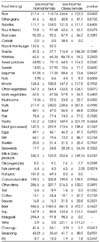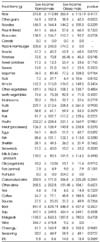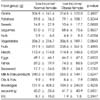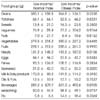Abstract
This study aims to identify the dietary patterns relevant to obesity of Korean women among low income classes. Adults 20-64 years were used as study subjects from the data of 2005 Korea National Health and Nutrition Examination Survey. We compared obese and normal-weight women in terms of their nutrients intake, diet quality and food patterns. Diet quality was assessed by using the Nutritional Adequacy Ratio (NAR) and Index of Nutritional Quality (INQ). Our results showed higher prevalence of obesity among lower socioeconomic status women. In men, there were no significant associations with socioeconomic status and prevalence of obesity. Higher risk of nutritional inadequacy was observed among obese women compared to normal weight women. Obese women showed significantly lower INQ for nutrients such as Ca, Fe, Vitamin A, Thiamin, Riboflavin and Vitamin C compared to other women. They consumed significantly higher amount of rice (p < 0.05) and lower amount of vegetables (p < 0.01). By contrast, obese men from low income classes showed higher intake of those nutrients. Obese men also consumed significantly higher amount of meats than normal weight men. Therefore, this study suggests that genderspecific approaches based on economic situation should be considered in developing the intervention program for managing obesity for low income classes.
Figures and Tables
References
1. Bandini LG, Schoeller DA, Cyr HN, Dietz WH. Validity of reported energy intake in obese and nonobese adolescents. Am J Clin Nutr. 1990. 52:421–425.
2. Chang MW, Baumann LC, Nitzke S, Brown RL. Predictors of fat intake behavior differ between normal-weight and obese WIC mothers. Am J Health Promot. 2005. 19(4):269–277.
3. Darmon N, Briend A, Drewnowski A. Energy-dense diets are associated with lower diet costs: a community study of French adults. Public Health Nutr. 2004. 7(1):21–27.
4. Drewnowski A, Specter SE. Poverty and obesity : the role of energy density and energy cost. Am J Clin Nutr. 2004. 79(1):6–16.
5. Drewnowski A, Darmon N. Food choices and diet costs : an economic analysis. J Nutr. 2005. 135(4):900–904.
6. Epstein LH, Dearing KK, Paluch RA, Roemmich JN, Cho D. Price and maternal obesity influence purchasing of low- and high-energy-dense foods. Am J Clin Nutr. 2007. 86(4):914–922.
7. Kim BR, Han YB, Chang UJ. A study on the attitude toward control, diet behavior and food habits of college students. Korean J Community Nutr. 1997. 2(4):530–538.
8. Kim EK, Lee JS, Hong HO, Yu CH. Association between Glycemic Index, Glycemic Load, Dietary Carbohydrates and Diabetes from Korean National Health and Nutrition Examination Survey 2005. Korean J Nutr. 2009. 42(7):622–630.
9. Kinsey JD. Food and families socioeconomic status. J Nutr. 1994. 124(9 Suppl):1878S–1885S.
10. Korea Centers for Disease Control and Prevention. Korea Health Industry Development Institute. In-depth analysis on the 3rd Korea Health and Nutrition Examination Survey: Nutrition Survey. 2007.
11. Ledikwe JH, Blanck HM, Khan LK, Serdula MK, Seymour JD, Tohill BC, Rolls BJ. Low-energy-density diets are associated with high diet quality in adults in the United States. J Am Diet Assoc. 2006. 106(8):1172–1180.
12. Lee SM. Association of whole grain consumption with sociodemographic and eating behavior factors in a Korean population: Based on 2007-2008 Korea National Health and Nutrition Examination Survey. Korean J Community Nutr. 2011. 16(3):353–363.
13. Lee Y, Lee HS, Jang YA, Lee HJ, Kim BH, Kim CI. Dietary intake pattern of Korean adult population by weight status - 2001 National Health and Nutrition Survey. Korean J Community Nutr. 2006. 11(3):317–326.
14. Marín-Guerrero AC, Gutiérrez-Fisac JL, Guallar-Castillón P, Banegas JR, Rodríguez-Artalejo F. Eating behaviours and obesity in the adult population of Spain. Br J Nutr. 2008. 100(5):1142–1148.
15. Moon HK, Kong JE. Assessment of nutrient intake for middle aged with and without metabolic syndrome using 2005 and 2007 Korean National Health and Nutrition Survey. Korean J Nutr. 2010. 43(1):69–78.
16. Park JA, Yoon JS. Dietary behaviors and status of nutrient intakes by the obesity levels of housewives in Daegu. Korean J Community Nutr. 2005. 10:623–632.
17. Phillips SM, Bandini LG, Naumova EN, Cyr H, Colclough S, Dietz WH, Must A. Energy-dense snack food intake in adolescence: longitudinal relationship to weight and fatness. Obes Res. 2004. 12(3):461–472.
18. Robinson WR, Gordon-Larsen P, Kaufman JS, Suchindran CM, Stevens J. The female-male disparity in obesity prevalence among black American young adults: contributions of sociodemographic characteristics of the childhood family. Am J Clin Nutr. 2009. 89(4):1204–1212.
19. Song YJ, Paik HY, Joung HJ. A comparison of cluster and factor analysis to derive dietary patterns in Korean adults using data from the 2005 Korea National Health and Nutrition Examination Survey. Korean J Community Nutr. 2009. 14(6):722–733.
20. St Jeor ST, Perumean-Chaney S, Sigman-Grant M, Williams C, Foreyt J. Family-based interventions for the treatment of childhood obesity. J Am Diet Assoc. 2002. 102(5):640–644.
21. Stolley MR, Fitzgibbon ML. Effects of an obesity prevention program on the eating behavior of African American mothers and daughters. Health Educ Behav. 1997. 24(2):152–164.
22. Townsend MS, Aaron GJ, Monsivais P, Keim NL, Drewnowski A. Less-energy-dense diets of low-income women in California are associated with higher energy-adjusted diet costs. Am J Clin Nutr. 2009. 89(4):1220–1226.
23. Wamala SP, Wolk A, Schenck-Gustafsson K, Orth-Gomer K. Lipid profile and socioeconomic status in healthy middle aged women in Sweden. J Epidemiol Community Health. 1997. 51(4):400–407.
24. WHO. Obesity. Report of WHO Consultation of obesity. 1997.
25. Won HR. A study of the relationship between the eating attitude influenced by eating Disorder and body shape, nutritional knowledge among female college students in Won Ju province. Korean J Community Nutr. 1998. 3(2):308–316.
26. Woo J, Cheung B, Ho S, Sham A, Lam TH. Influence of dietary pattern on the development of overweight in a Chinese population. Eur J Clin Nutr. 2008. 62(4):480–487.




 PDF
PDF ePub
ePub Citation
Citation Print
Print












 XML Download
XML Download